There’s a whole sub-genre of books that can be described as “History… IN SPACE!”—for example, Valor’s Choice by Tanya Huff and David Weber’s Honor Harrington series—and are a wonderful means of introducing readers to different historical periods in a thoroughly engaging way. Most of what I know about the Zulu and Napoleonic Wars I encountered first in one of those books. In the realm of fantasy, Rebecca Roanhorse’s Black Sun exposed readers to cultural aspects of Mesoamerican societies that they had potentially not previously encountered. And of course there exists an entire website devoted to exploring the well-known connections between Game of Thrones and the War of the Roses, along with other historical inspirations for the Song of Ice and Fire series.
In many cases, those relationships between historical events and people and the fiction they inspire are relatively obvious—right there on the label, as it were. But of course, there are more subtle influences and echoes of history that reverberate through SFF, parallels that might be harder to pick up on, but which can still inform and challenge the way we think about the world…
The Raven Tower by Ann Leckie (2019)
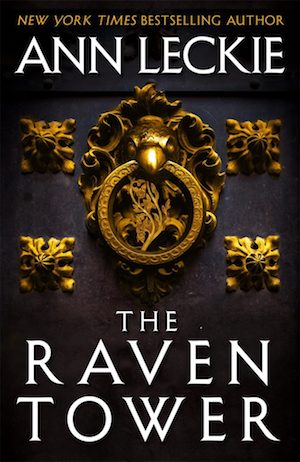
The Strength and Patience of the Hill, who narrates The Raven Tower, is a big rock—who also happens to be a god. According to Adrienne Mayor’s The Amazons, the Scythians of the Eurasian Plains happened to worship a very particular large black stone:
Veneration for a sacred black stone was a prominent feature of ancient Anatolian worship of the great “mountain mother” Cybele of Asia Minor. […] At Cybele’s sanctuary at Pessinus in central Anatolia, the goddess was worshipped in the form of “a black stone that fell from the sky.” (from Chapter 10, the “Amazon Religion” section.)
This sort of veneration of a meteorite is relatively unusual from a historical perspective. Ann Leckie does a fantastic job of showcasing how this sort of religious belief might come to be, without at any point being dismissive toward the beliefs and practices of different cultures. The Strength and Patience of the Hill is one of many gods who play a role in The Raven Tower, which relies on the trope of gods gaining strength through faith and worship.
During the “flashback” scenes of The Raven Tower, Strength and Patience of the Hill makes an effort to stay out of the affairs of the world. It is, in fact, moderately appalled to discover that people have been worshipping and praying to it, because in many cases, Strength and Patience of the Hill deliberately ignored the prayers of the faithful, deliberately failing to respond to attempts to use rune-stones for communication. But sheer chance and coincidence were enough to convince people that Strength and Patience of the Hill was listening, and helping.
Looking back into real-world history, one can imagine the ancient Phrygians having a similar sort of relationship with Cybele.
***
The Sun Sword Series by Michelle Sagara West (1995-2019)
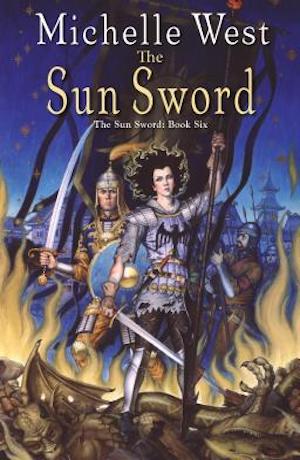
Serra Diora di’Marano is a woman born to harem life, who finds peace with the harem, and is able to use the power of her beauty, her musical talents, and her familial connections to seize power and become, in essence, a kingmaker. Although the series features many powerful women, it does not shy away from depicting the ways different cultures perceive and enforce gender roles.
The Essalieyan Series as a whole is incredibly complex—The Sun Sword was apparently pitched as a duology and became six books nestled in the middle of a ten book series. What really stood out, though, was the power Diora was able to seize despite never stepping outside of an incredibly circumscribed role. The series never flinches away from showing how different cultures limit and control women—but at the same time, it does a great job of showcasing how women can still manage to achieve power and agency, even in a conservative culture that effectively banishes women from public life.
When the average reader imagines a Syrian princess from the Bronze Age, “powerful diplomat” is probably not the image that springs to mind. “Kingmaker” is a term applied to women only rarely, and usually only in cases where male heirs were thin on the ground. But in the Fertile Crescent, both terms applied to princesses. According to Brotherhood of Kings by historian Amanda Podany, Syrian princesses served in a vital diplomatic role. It wasn’t just because their marriages and motherhood bound their fathers and husbands together in common cause, either. Princesses wrote frequent letters home, facilitating and easing the relationships between kings by giving critical advice based in their unique insight and access—they were often considered to be one of the only people a king could trust to give honest, accurate advice. And for much of Egypt’s history, who the Pharaoh’s eldest daughter married had a much greater impact on who would rule than who his eldest son may have been. (Note: As pointed out in the comments, this research has since been discredited.)
***
The Corean Chronicles by L. E. Modesitt, Jr. (2002-2011)
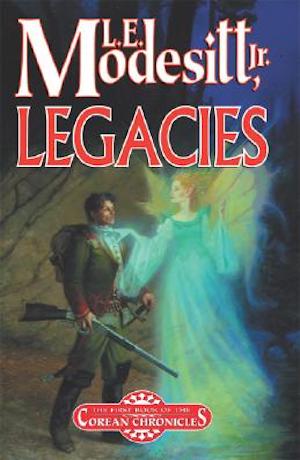
While L.E. Modesitt, Jr. generally eschews “shameless copies of history” in fiction, he demonstrates a thorough and historically grounded understanding of how societies function throughout his own work. So while the Duarchy at the heart of The Corean Chroniclesis not a particularly close mirror of Roman society, there is still a lot to be gleaned about Rome from it. The series begins at the end, historically speaking, with the protagonist of Legacies living millennia after the fall of the Duarchy featured in Alector’s Choice. The time of the Duarches featured significantly more impressive technology than the world that remains centuries later. Alucius’ experiences as a young man growing up surrounded by technology that would be impossible to replicate can help the reader empathize with how Medieval herders living in the shadow of the fallen Roman Empire might have felt, looking at aqueducts they didn’t know how to repair and roads whose quality they couldn’t hope to replicate.
It’s a particularly close parallel given that at times the Roman Empire, much like early Corus, was ruled by two leaders who collaboratively presided over different geographic spheres. Though Rome didn’t start out with a pair of rulers, co-consuls were common during the Republic, and the Emperor Diocletian’s reforms split the Empire into Eastern and Western halves that ultimately resulted in the rise of Byzantium.
***
A Memory Called Empire by Arkady Martine (2019)
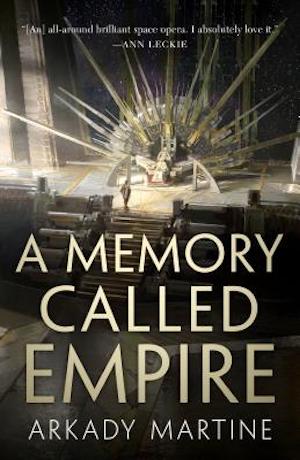
Arkady Martine has been upfront about drawing inspiration from historical sources, writing about borrowing from Byzantine and Mesoamerican history for her first novel, A Memory Called Empire. One of the neatest little touches in the book, though, is in the formulation of Teixcalaanli character names, which are made with numbers paired with nouns, where both parts have symbolic meaning. Although names like “Three Seagrass” may sound a little strange to the Western ear, they do illuminate the startling variety of naming conventions that have existed throughout history.
The effect is a subtle sort of reminder that different cultures consider and interact with names differently. A name like Rufus Scipio (which literally means Red Staff), might remain Latinized in a book inspired by Roman history, but in a culture where names carry symbolic or specific types of cultural significance, not simply assigned as a convenient way to differentiate between individuals, the meaning itself is what is important.
***
The Dresden Files by Jim Butcher (2004—Present)

Although tropes about Faerie, including the idea of the Summer and Winter courts, binding oaths, and an aversion to iron come out of the Celtic tradition, many of these ideas predate even the oldest of the gods that appear in The Dresden Files series. The long history of hospitality rites and guest/host relations, for example, goes back farther than most people think—predating even Homer’s Iliad, in which two rivals immediately stop their fight when they realize that their grandfathers had a guest-host relationship.
Back around the time that the horse was first domesticated, formalized guest/host relationships were vital to mobile herders. These relationships offered a way to distinguish between people who would travel through a particular pasture within one’s territory and follow the norms and rules necessary to keep their lifestyle functional—and those who couldn’t be trusted and should therefore be driven out.
The Dresden Files make this ancient philosophy more accessible and relatable to a modern reader. If we imagine the Nevernever as a landscape not dissimilar to the ancient Eurasian plains, we can start to put the pieces together of how considerations of trust and territory—which matter so much to the beings of the Nevernever that they literally cannot violate their oaths—might have looked to our ancestors.
***
One of the great wonders of speculative fiction—and fiction in general—is how it gives us an opportunity to empathize with people in situations and contexts far removed from our own. After all, narratives help us learn. Please share in the comments any experiences you’ve had where a SFF story helped you discover an obscure piece of history, or helped illuminate past cultures, people, and events.
Eleanor Konik studied philosophy and religion before graduating law school in 2011. These days, she teaches Ancient Civilizations and spends the bits of time left over writing stories that bring history—and magic—to life. You can find more articles about worldbuilding, ancient civilizations, and mythology at her website.










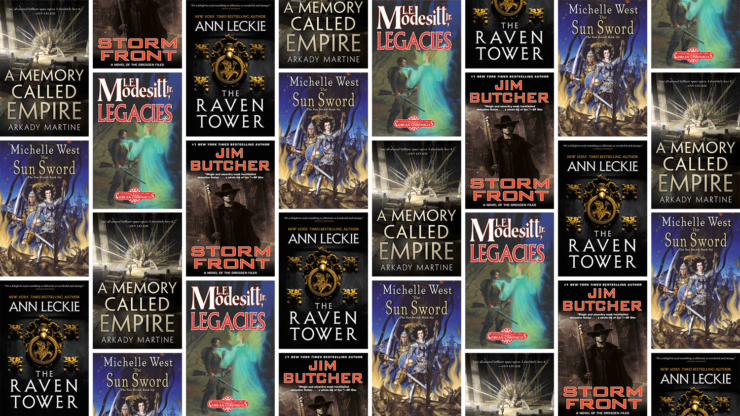
‘And for much of Egypt’s history, who the Pharaoh’s eldest daughter married had a much greater impact on who would rule than who his eldest son may have been’
I hope that’s not a reference to the long exploded ‘heiress princess’ theory. Pharoah’s throne descended to the eldest son of the Great Wife. When there was no such son the child of a secondary wife would be chosen. Frequently but not invariably he would be married to the daught of the Great Wife, if there was one, to unite the branches of the Royal family before they had a chance to diverge. Brother-Sister marriage was common in the royal family probably partly because nobody less than royal was good enough to marry a princess and partly to prevent outsiders from getting a claim to the throne through royal wives. Yet some princesses did marry outside the royal family, Thutmose I seems to have been the brother in law of his predecessor Amenhotep I.
Royal harems are much misunderstood organizations. They are less fancy private bordellos than homes to a monarch’s extended family and numerous female servants and officials needed to run it. The latter were very much in the majority and it was possible for a woman to have a successful career as an official. Personally I find harems fascinating as communities of women in which friendships and alliances exist as well as competition. Limited yet with the great potential due to their closeness to power.
Thanks for this interesting article! Just wanted to riff more on the discussion on A Memory Called Empire — the book concerns Byzantine history, and Lsel station (from the Armenian verb lsel, to hear) is the analogue to the Armenia, which tried to maintain sovereignty from the Byzantines, but also had powerful figures like Grigor Magistros who immersed themselves in Byzantine culture and served in Byzantine offices.
The book also goes deep in a lot of other ways beyond that basic setup. The ‘Armenian’ characters use Armenian sounding phonemes in their names; Mahit is fascinated by the complexity of the ‘Byzantine’-analogue 15 syllable poetry (Armenians had a rich poetic tradition too, of course, but not always the same volume of complex stuff that gets produced for Byzantine courts or powerful Byzantine patrons); the Lsel emphasis on the transmission of memory as the most important thing (which becomes maybe even more important to a proto-diasporic group than territory, in a way, especially after the collapse of the Armenian kingdoms in the 11th cen, after which the kingdom of Armenia moves to Cilicia).
tl;dr — what a fascinating book, so worthy of analysis and attention!
And here I thought your footnote was going to point out that in ancient Egypt, who the Pharaoh’s eldest daughter married and who the Pharaoh’s eldest son was could have been the same person.
@1 I’m not an expert on all things Egypt — my knowledge base tends more toward breadth than depth — so I do want to apologize for the error! Egyptologists thought for a long time that power ran through the maternal line, and most of my research has been focused on Šuppiluliuma (and the Egyptian queen who was trying to marry his son) so I seem to have missed that detail in my investigation. I appreciate you correcting the record (and I’ll make sure to get the article updated ASAP).
@2 It’s definitely possible to devote several articles to plumbing the depths of the multitude of historical references in A Memory Called Empire. Discussing it with a friend was actually the original impetus behind this entire article :)
@@.-@, The heiress princess theory was popular for a long time. It was decisively disproven sometime in the middle of the last century by Egyptologist Barbara Merz, better known to readers as Elizabeth Peters or Barbara Michaels. But the idea still circulates. In Egyptology old theories never seem to die.
The story of the Egyptian Queen and Suppiluliama is so darn weird. She’s literally inviting a rival monarch to take control of her country. What was she thinking? The queen is usually identified as Ankhesenamon, Tut’s widow but there’s no evidence of a disputed succession there. Ay seems to have stepped right in. However there’s a very fuzzy period between the death of Akhenaten and the succession of Tutankhamen in which there seems to have been two rival kings each claiming to be Akhenaten’s successor and one of whom was a woman. Was Suppiluliama’s Egyptian Queen Ankhkheperure Neferneferuaten?
In Prelude to Foundation by Asimov, the folks of Mycogen on Trantor had number noun names, where the noun was family related.
There are about a bajillion military SF books based on the career of Byzantine general Belisarius. The oldest mention of Belisarius I’ve encountered in SF is Lest Darkness Fall by L. Sprague DeCamp, and he may be the author that pointed the next generation of SF writers in that direction. For example, David Drake has used Belisarius as an inspiration in a number of his books, and is one of the best of the military SF writers who mine history for story ideas.
I’d think most of Aliette de Bodard’s Universe of Xuya shorts/novellas fit this topic, considering they’re heavily based on Vietnamese cultural history and imagine a world where the “East” became spacefarers long before the traditional “West.”
For the longest time I’ve had a “anything but Rome” attitude toward scifi/fantasy. Yes, Asimov’s Foundation series (largely) successfully used that template, and yes there are other good ideas to be mined for Rome outside those already explored, and it is a testament to the Romans that their oversized presence on our imagination still lingers, but: it’s been done to death. Any time anyone wants to evoke imperial power or great civilization, to pseudoRome we go, often with far more outdated historical touchstones as references than the referenced Egyptian one in this article. Even Byzantium (which is basically Rome 2.0ish) doesn’t get explored as often as one would think, which I why I’m glad to see it serving as a model in a book on this list (I’ll have to add it to my vast To Read pile).
One clarification I’d make: while it’s certainly true the wives of a harem functioned as diplomats, this role as described was not limited to the Fertile Crescent. The briefest glance at history in any culture will provide many examples of royal wives and daughters who furthered either their or their husband’s national interests through many different avenues of diplomacy.
Two examples by Tim Powers: Both The Anubis Gates and The Drawing of the Dark are good. The former, if I remember right, takes place in the 19th century, while the latter is set in the 16th century with the Ottoman Empire on its campaign to absorb Vienna.
I am embarrassed to admit that I knew almost nothing about the Ottoman Empire until I read The Drawing of the Dark.
@7 Ahhh I love what David Drake has done with Belisarius! For this article I was mostly focused on connections that weren’t sort of “obvious from the label” but if I were doing a list of SFF books that were my first introduction to a particular historical time period, David Drake would be right up there with David Weber and Tanya Huff from my intro paragraph. And for that matter, Jim Butcher’s Codex Alera was my first introduction to the Lost Roman Legions. “A Natural History of Dragons” does a lot of really fascinating stuff in this space, too.
@8 Thanks for mentioning “Universe of Xuya” — definitely right up my alley. I think I missed it because I normally only look at longer fiction, but it looks amazing and I just sent a sample to my ebook library :) Also, I feel you on the “Anything but Rome” thing. Miles Cameron’s Traitor Son Cycle shocked me with how much I like it because these days I avoid riffs off of Medieval Europe as much as possible. I only picked it up because he’s a friend of an internet-friend (Sean Manning, an academic who studies & blogs about the Achaemenid Empire) and boy am I glad I did. (Also, again, I’m really grateful the error was pointed out and that Tor was able to get an update through on the article! Scott Alexander once said that the fastest way to get an answer to a question isn’t to ask, but to state a wrong answer in public, and as much as I hate to be responsible for any spread of misinformation, he wasn’t wrong, heh.)
@10 You’re welcome, and no worries on the error, we all make them (as my very blatant typo in my second paragraph proves). The trick is how well we acknowledge/correct them.
Re: “Avoid riffs of Medieval Europe;” I have no problem with more medieval fantasy so long as it is actual medieval fantasy; more often than not, what people think of as medieval comes across very Renaissance (actually, it’s usually more Ren Faire, which are fun to attend, but should not be the basis of all your “research”). And as always, character and story count a lot toward making even the most common premise interesting. Still, it might be nice to shake up the old tropes in a typical fantasy by weaving in some actual historical details uncommon to many readers, like kings traveling around to hold court instead of staying holed up in a castle.
@11 In that case, I definitely want to highly recommend Miles Cameron’s Traitor Son Cycle! I liked it so much I actually wrote a review for it on my blog, which I almost never bother to do. Miles Cameron has a degree in history; he’s also the kind of reenactor who really goes whole hog with being a weapons expert (he’s actually fought “in the lists” in Italy) and going “on location” for reenacting, and the series gets down and dirty into the nitty gritty of stuff like how the laundry got handled (and not just in passing, either!).
The bit about intriguing (in both senses) princesses reminds me quite a bit of the Sirniakan Empire in Kate Elliott’s _Crossroads_ series, to the point where I wouldn’t be surprised if they drew on some of the same historical sources. Most of that series is set outside the Empire, but one major character is half-Sirni, the product of a diplomatic marriage, and succession issues can turn murderous.
I wonder if you’d include Jo Walton’s Sulien series (The King’s Peace, The King’s Name, The Prize In the Game), which between them are a cross between the Matter of Britain and the Ulster Cycle, including references to Roman history from right after their leaving of Britain.
(Entertaining and well written, but for somebody more familiar with the source matter it might seem sometimes that the serial numbers are just barely filed off.)
IIRC, the analog to early Christianity in those novels uses small, smooth stones instead of a cross as objects of identity and veneration, presumably because the founder was martyred by crushing rather than crucifixion.
As for the deity that’s a big rock, it reminded me that there are also the Black Stone in the Kaaba and the representation of El Gabal, the Arab-Roman sun god that began as the Ba’al or chief god of Emesa (Homs) in Syria, notable mainly because the infamous Roman emperor Elagabalus was its chief priest. The latter is the best known but not only example of a baetylus (from Semitic bet el, “house of god”); the Kaaba’s Black Stone possibly started out as such an object as well.
Of course, there’s a difference between being the house of the god and simply being the god …?
I really enjoyed the “curse of chalion” which is inspired by the unification of spain.
I also liked “City of stairs” and the take on colonisation and decolonisation, guilt and force.
Guy Gavriel Kay has many books that, while fictionalized, have strong elements from real places during real historical periods. Plus I love his work.
Also, since no one else pointed it out, I was amused that you referenced Rufus Scipio (Tavi’s Alias in the Codex Alera) in the blurb for a different book right before you talked about an actual Jim Butcher book :)
John Crowley’s Aegypt quartet (first volume was originally published as Aegypt, but was later published under its intended title of The Solitudes; it is followed by Love & Sleep, Deamonomania and Endless Things) is about half in the twentieth century and half in the late 16th/early 17th; the latter parts bring a number of different bits of history (and historical thinking) vividly and marvelously to life, including John Dee and Giordano Bruno.
Ahhhh, very interesting! Thank you for these recommendations.